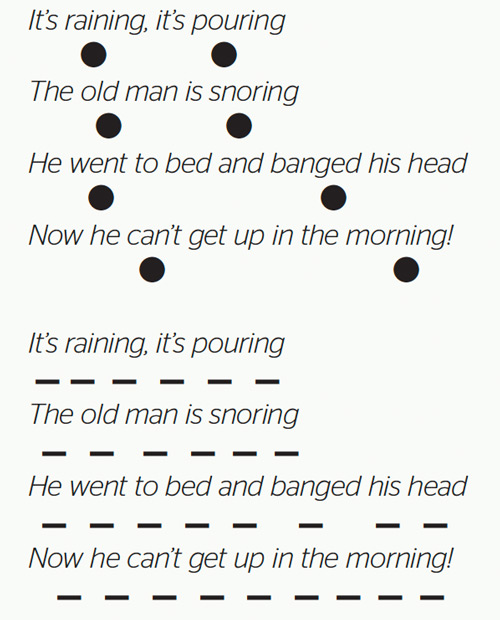Maria Kay highlights the close relationship between music and literacy in the early years, and suggests simple rhythm games to help you develop children’s skills…
Usha Goswami, a professor of cognitive developmental neuroscience at Cambridge, has found the perception of rhythm to be important to literacy.
She has undertaken research specifically with dyslexic children. In Growing Children (BBC Four, 2012) she stressed the importance of rhythm games in preschool to support language development.
These include nursery rhymes, songs, language games, stepping, clapping, action rhymes and large motor movement.
Words can be divided into syllables – chunks of sound. For example, the word, ‘ex-am-ple’ has three syllables. The ability to ‘chunk’ words in this way is an important skill that helps us to break down words into simple units when we are reading or spelling.
The rhythm in a song often reflects the syllables in the lyrics. Examine the rhyme below, ‘Can You Hear the Falling Rain’, and you’ll be able to see how the syllables in words are given a note each.
For example, ‘fal-ling’ is one word but it has two syllables and it is sung on two notes. Helping children to identify syllables by highlighting them through music is an effective method of helping children to break down words.
Adding movement too, to highlight the syllables, adds further emphasis. Hence, marching, clapping, dancing and playing instruments help to embed vital literacy skills.
Can you hear the falling rain?
Listen here it comes again.
Down the river, down the lane,
Tapping on the window pane.
To emphasise the rhythm use claves (sticks), clap your hands or tap on a drum. If you use a drum you can vary the sounds of the rain falling, flowing down a river, on a road or on a window.
This rhyme can also be used as a basis for discussion about rain and the sound it makes as it hits different surfaces or flows in a river. You could compare this to the sound of the crashing waves of the sea or water from a tap.
On the same ‘rain’ theme, recite this traditional rhyme – it is usually performed as a chant (more singsong than a spoken rhyme, yet not quite a song).
The circles indicate the beat of this rhyme and the lines, the rhythm (also reflects the syllables in each word).

Tap the beat and then tap the rhythm to compare them. When you tap the beat, only tap where indicated by the dots. When tapping the rhythm, tap where indicated by the bricks.
The rhyme ‘Cobbler Cobbler’ can be used in the same way too. See if you can identify the beat and the rhythm…
Cobbler, cobbler, mend my shoe,
Get it done by half past two
‘Cos my toe is peeping through,
Cobbler, cobbler mend my shoe.
Here’s another activity that will help identify syllables. Pass a beater around the children in turn; you hold a drum.
Ask the children a question such as, “What did you have for breakfast?”, The children have to reply and beat out the syllables on the drum as they speak.
For example; ce-re-al = three beats (syllables); toast and jam = three beats (syllables).
I have found that some children who have difficulty with spelling have not learned to tap rhythms. Even older children can benefit from tapping out the rhythms in words.
It helps to break the words down into smaller, more manageable units that are easier to read and spell. The ability to pay careful attention to the sounds within words is vitally important to proficiency in literacy.
Maria Kay is the author of Sound Before Symbol: Developing Literacy Through Music and Alphabet Book + More: A Sounds and Symbols ‘Literacy Through Music’ Book.

Nature crafts – Make your own rainforest
Editors picks

STEM learning through play
Editors picks
